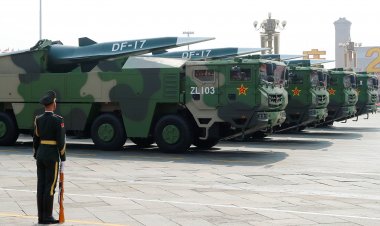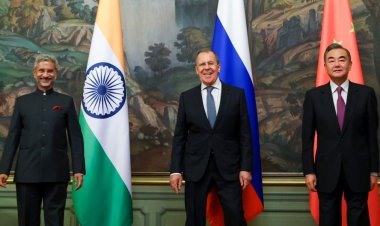From Predator to Partner: The Evolution of Drone Warfare

Analysis
By Sharath Kumar Kolipaka
Until recently, most drones were used in low-intensity conflicts against non-state actors — insurgents, terrorist groups, or isolated targets with limited air defences. In the early 2010s, drones like the MQ-1 Predator and MQ-9 Reaper symbolised America’s asymmetric warfare strategy. They were slow, high-endurance, and built for surveillance and selective strikes in uncontested airspaces. They excelled in precision strikes in places like Afghanistan, Yemen, or Somalia, where the risk of being shot down was low. But that’s no longer the whole picture. Drones have moved from niche tools for counterinsurgency to central, multi-role assets in high-end, state-on-state conflict. The 2020 Nagorno-Karabakh conflict was a watershed moment: drones weren’t just supporting roles or optional tools — they were front and centre, disabling armoured columns, destroying radar systems, and reshaping the battlefield with unprecedented autonomy and precision. It wasn’t the first time drones appeared in a state-on-state conflict, but it was the first time their impact was so visible, decisive, and public.
Since then, the trend has only accelerated. In Ukraine, loitering munitions and improvised UAVs are being used on a massive scale — not just for strikes but for reconnaissance, electronic warfare, and attrition. Along the India-Pakistan border, and in the increasingly public drone duels between Israel and Iran, we’re seeing militaries test each other’s airspace with low-cost, high-impact unmanned systems. These are no longer one-sided encounters: they involve countries with radar networks, jamming capabilities, and layered air defences. In response, military investment has shifted toward developing drones that can operate in this kind of contested environment, not just fly through it, but survive, adapt, and return with results.
That shift reflects a broader strategic recalibration. Instead of drones being tools for fighting insurgents in the shadows, the focus is now on preparing for wars between technologically advanced adversaries, where the enemy has modern aircraft, long-range missiles, and real-time battlefield awareness. The flashpoints have also moved: U.S. and Chinese defence planners increasingly focus on the Taiwan Strait, the South China Sea, and the wider Indo-Pacific regions where drones would need to operate alongside manned aircraft, jam enemy systems, act as decoys, or even carry out independent strikes in the face of advanced threats. As a result, the drone itself is being reinvented. It’s no longer just a flying camera or a missile with wings. It’s becoming a teammate, a decoy, a jamming platform, and a combat asset — all rolled into one.
One of the most exciting ideas shaping future drone warfare is the concept of the “loyal wingman.” Instead of having a human wingman, pilots are accompanied by two or three unmanned aircraft. These drones aren’t just following—they’re actively scanning the battlefield, jamming enemy radars, or even launching their weapons.
These UCAVs can carry sensors that extend the pilot’s situational awareness. They can fly ahead to attract enemy missiles—decoys that save lives. And they can perform electronic warfare, disrupting enemy systems without risking a pilot’s life. The goal is to create a force multiplier: one human controlling multiple drones, working as a team to dominate the skies.
The U.S. has long been a leader in drone technology, and it’s now focusing on building smarter and more autonomous systems. The XQ-58A Valkyrie was a standout project: a fast, stealthy drone designed to fly alongside fighter jets. It is capable of runway-independent launch and land operations. It can be launched from smaller platforms with the assistance of rockets and land using parachutes. It has changeable nosecones with a versatile range of sensors to fit in according to the operational needs. The XQ-58A has a range of 3000 NM (5556 KM) and can operate at 50,000 ft above ground level (AGL) to 45,000 ft mean sea level (MSL). It uses a turbofan engine which has a thrust of 2000 lb (907.18 KG). The aircraft is 30 ft long with a wingspan of 27 ft, and it can take off with a maximum weight of 6000lb (2721.5 KG). It can reach a max speed of 0.85 Mach and a cruising speed of 0.70 Mach. It has an internal bomb bay to accommodate 2 GBU-39 or any similar ordinance. It can also carry AIM-120 anti-air missiles or anti-radiation missiles on its wings.
General Atomics XQ-67A OBSS (off-board sensing station) under collaborative combat aircraft (CCA) acting as a scout or weapons and sensors carrier. It’s affordable enough to be considered expendable, which could fundamentally change how the Air Force plans missions. The USA might start the integration of the autonomous drones and manned aircraft with the F-22s of the USAF. This project is more important than its current results show; it is part of the LCAAPS (Low-Cost Attritable Aircraft Platform Sharing ) programme under which General Atomics Aeronautical Systems Inc. and Force Research Laboratory are working on the development of a chassis, termed a “genus”, as the foundational core architecture from which several “species” of aircraft can be built. XQ-67A OBSS is the first "species" to be designed and built from this shared platform
Another interesting aspect of Loyal Wingman is the F-16 Venom. The "F-16 Venom" refers to the Viper Experimentation and Next-gen Operations Model Autonomy Flying Testbed program, or VENOM, which is modifying six F-16 fighter jets to test autonomy capabilities. The program aims to accelerate the development of autonomy software for both crewed and uncrewed aircraft by using the F-16 as a testbed.
These developments consist of software, hardware, and instrumentation to enable the aircraft to fly autonomously. An autonomous F-16 is not attritable as the drones which are currently in contention to be the loyal wingman, costing from $14 million and reaching up to $70 million.
Another key project, which unveiled the “Areal teaming system“ (ATS), is the Boeing Phantom Works MQ-28 Ghost Bat, being developed in partnership with Boeing Australia. This is a flying wing design drone that will work alongside manned aircraft in complex missions, helping the pilot with reconnaissance and electronic warfare. This has completed over 100 hours of flight testing and might enter service soon.
Both the XQ-58A and MQ-28 are manufactured as a resin-infused single composite piece to reduce moving parts, which is an advantage when trying to be stealthy. It can also do quick swaps of the nose sections for mission-specific equipment.
MQ 25 sting ray a tanker drone a Carrier-Based Aerial-Refuelling System (CBARS), according to Boeing, the primary capability of this drone is to extend the range of a carrier’s air wing, as a secondary capability, it can be used for ISR missions as well. This drone can receive commands from air vehicle pilots from the aircraft carrier and the pilot in the cockpit of the aircraft that is getting refuelled as well. The MQ-25 T1 played a major role in learning in the development of the MQ-25. This shows the diversified investment into UAVs, not just for combat but also for logistics to support the combat.
China
China is pushing hard to close the drone gap with the U.S. and is making significant progress. Its Feihong FH-97A drone is a direct response to America’s Valkyrie, built with similar loyal wingman capabilities. It's developed by Aerospace Times Feihong Technology Corporation.
It is designed to fly alongside J-20, J-35 fighter jets of China. It also has similar runway-independent take-off capabilities to XQ-58A with the help of rocket boosters. It can be used to disrupt enemy air defence systems and also carry 8 air-to-air missiles or loitering munitions.
The Hongdu GJ-11 Sharp Sword is a stealthy, flying-wing drone designed by Shenyang Aircraft Design Institute (SYADI) and Hongdu Aviation Industry Group (HAIG), and is part of seven proposed models by the Aviation Industry Corporation of China (AVIC) program called "AVIC 601-S”. It is designed for deep strikes—likely intended to penetrate heavily defended airspace like Taiwan or the South China Sea. It is also capable of taking off from China’s Type 076 amphibious assault ship. The prototype took its first flight in 2013, and there are reported appearances from time to time. This drone has a major role to play in the event of a conflict in the Indo-Pacific region, be it Taiwan or the South China Sea. This will be a strategic addition to the People’s Liberation Army Navy (PLAN).
China is also giving more attention to unmanned cargo drones like AVIC TP 500 and Tengeon Scorpion D. The single-engine TP 500 has a maximum take-off weight of 1400 KG (3,100 lb). This is not a military craft, but it can play a key role in the logistics of every sector. The scorpion D is a twin-tailed four-engine cargo drone with a maximum take-off weight of 4.5 tons. It has two cargo doors and is designed for maximum cargo and range. Tengeon has earned praise for its previous UCAVs twin twin-engine TB-001 and TB-A series, which were deployed in contested territories like Japanese islands and the Taiwan Strait by the People’s Liberation Army Air Force (PLAAF). The deployment of these cargo drones by the PLA on a large scale will call for a new understanding of the capabilities.
Then there’s the mysterious Aviation Industry Corporation of China (AVIC) WZ-8, a high-speed, high-altitude (100,000-160,000 ft different claims by Chinese media and US leaked intel) reconnaissance drone. It’s designed for one job: racing into enemy airspace at supersonic speed (Mach 3), gathering intel, and getting out fast. These programs reflect China’s growing emphasis on autonomous warfare and penetrating ISR missions. It cannot take off on its own and may be launched from the H-6 M Badger Bomber. It is 11.5 Meters long with a wingspan of 6.7 Meters, powered by 2 rocket engines. The design and operations of the drone remind the 60’s Lockheed Skunk Works’ D-21, the single-use high-speed drone which collects intel and releases the camera module for retrieval, then self-destructs.
One more significant development from AVIC is its Jiu Tian nine Sky SS-UAV, claimed to be capable of a take-off payload weighing 18 tons, with a range of 7,000 km flying at an altitude above 15,000 meters. Jian Tian is also capable of deploying small drone swarms in enemy territory. It has a maximum speed of 378 kts and can stay in the air for 12 hours. This is believed to be designed to compete with the RQ-4 Global Hawk of the USA. But similar designs like the RQ-4 Global Hawk are not known for operating well in contested airspace. The feasibility of SS UAV against the advanced air defence system is the billion-dollar question about investing in similar technology.
The race to develop the next generation of drones is already underway, and it’s fierce. Nations are not just building drones; they're building strategies, doctrines, and entire future combat systems around them. Drones are no longer an afterthought; they’re front and centre in the battle plans of today and tomorrow.
In the coming years, we may see wars fought largely from the sky by unmanned systems. This transition forces a doctrinal and industrial shift: air forces must integrate autonomy, electronic warfare, attritable platforms, and new logistics concepts as part of the normal force structure. Those who adapt concepts, training, and procurement to harness drones as teammates and force multipliers will gain a disproportionate advantage in future aerial campaigns. Those who can design, deploy, and command these systems most effectively will hold a significant edge. The battlefield is changing, and these drones are leading the charge.
“Victory smiles upon those who anticipate the change in the character of war, not upon those who wait to adapt themselves after the changes occur.”
— Giulio Douhet, The Command of the Air (1921).
Disclaimer: This paper is the author's individual scholastic contribution and does not necessarily reflect the organization's viewpoint.
Sharath Kumar Kolipaka completed his master’s in Diplomacy, Law and Business from Jindal School of International Affairs, specializing in peace and conflict studies. He is a Research Fellow at The New Global Order.























